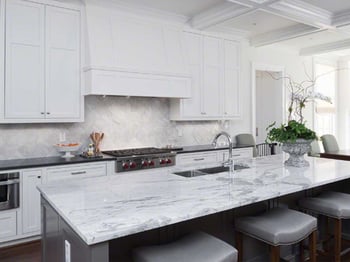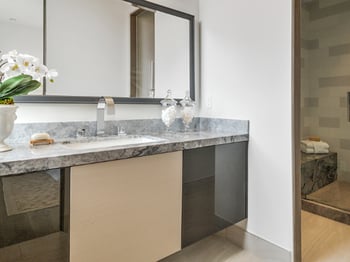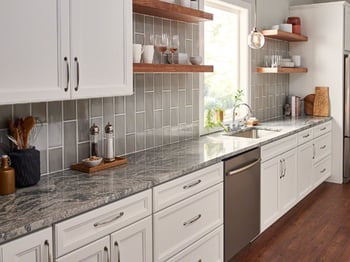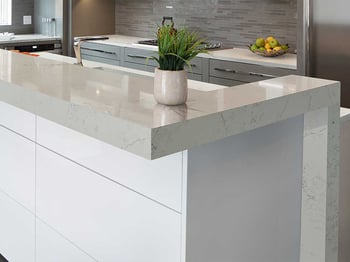Marble, granite, and quartz are three materials frequently used for kitchen and bathroom countertops. Two are natural, one is artificial, but with today’s manufacturing technology it can be nearly impossible to spot the difference with the naked eye.
Marble




Marble is one of the most elegant natural stones in the world. For centuries, it has been used to construct palaces fit for kings and statues dedicated to gods. If marble stone is free from all impurities, it will be solid white. Most marble, however, contains other minerals that can make it bluish, gray, pink, yellow, or black. However, these colors won’t be stark. Any other bright and vibrant colors likely indicate that the marble is human-made or that it’s a natural stone mixed with other materials.
True marble also has an unparalleled glossiness. This is often replicated in synthetic stones by adding small bits of glass and other materials, but it does not carry the same lasting shine of marble.
Marble is made naturally through thousands of years of heat and pressure. The colors of other minerals will appear as veins or swirls throughout the stone, with no repeating or symmetrical patterns and at varying depths and dimensions. Marble is also somewhat translucent, often allowing you to see a few millimeters past the surface, which gives the material more depth.
The reason marble is so popular with artists and architects alike is that it is relatively soft and easy to cut and carve. The most reliable way to tell if you are looking at real marble is to test its hardness by cutting with something sharp, like a knife. A real marble top will show scratches and etching over time. If you scratch a knife on a marble top (only do this on the underside of the slab) and don’t see the damage, the surface is likely granite or manufactured stone.
Granite




Another natural stone that’s popular for countertops, Granite, has also been used for thousands of years in buildings, bridges, and monuments. Mount Rushmore, the famous sculpture of U.S. Presidents George Washington, Thomas Jefferson, Theodore Roosevelt, and Abraham Lincoln, is sculpted in a granite outcrop in the hills of South Dakota. Because it contains an assortment of different minerals like feldspar, quartz, and mica, granite can come in many colors, but the most common ones are whites, grays, reds, and browns.
Granite is a phaneritic rock, meaning it contains crystals and clumps of minerals large enough to distinguish with the naked eye. When you look at a slab of granite, you see various pieces in a speckled pattern that come together to form the stone.
Some granite has more of a veined look, similar to marble, but if you look closely, the color patches tend to be grainier and blurrier, rather than distinct streaks. Unlike marble, granite is completely opaque, so you will only see the outermost layer of the surface.
Again, testing granite’s hardness by cutting it with a knife is another way to determine whether you are looking at granite or marble. However, telling the difference between granite and quartz takes a bit more of a keen eye since neither will scratch.
Quartz




While quartz occurs naturally, a quartz countertop is human-made. To make a quartz countertop, manufacturers must use a mix of ground quartz stone (about 90 percent) and resins and polymers (about 10 percent). Many “quartz countertops” can be a mix of ground granite, marble, other natural stones. These are more accurately called engineered stone.
Quartz countertops come in a seemingly endless variety of colors and patterns. To tell if you are looking at real stone or a manufactured countertop, look carefully at the pattern on the counter.
Every slab of granite or marble is unique. If it is natural stone, no two areas of the stone will look exactly alike. Because quartz slabs are manufactured, they tend to have a fairly uniform color and consistency throughout, with little variation in the patterns and textures. However, as new methods of engineering quartz slabs emerge, the possibilities of what can be done with the material are growing all the time, making it difficult to pin down.
The Best Option for Your Home
All three countertop materials, marble, granite, and quartz, have their pros and cons, but all three will add value to your home. In the end, the countertop material you choose is a matter of personal preference.
Cultured marble is another great countertop material option for your home. It’s a man-made product that’s both luminous and durable. Cultured marble comes in a broad range of colors, patterns, and shapes. At Kitchen & Bath Center, we have a broad selection of styles to choose from.
Planning to install new countertops? The expert team at Kitchen & Bath Center is ready to help.


